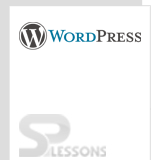 Introduction
Introduction
This chapter explains about WordPress Permalinks and the benefits of using URLs. WordPress allows to create Permalinks for the content to link the search engines and other websites to the respective website. Following concepts are covered in this chapter.
- Permalinks
- Permalinks Default Structure
- Permalink structure - Search Engine Friendly
 Description
Description
The URLs of the content published by client on the WordPress site are known as WordPress Permalinks. Permalinks are used to search a page in the browser address bar and connect search engines or different sites to the site.
Clients can change the structure of the WordPress Permalinks. This can cause the search engine traffic and referral traffic to drop considerably as visitors can see 404 page found error instead of a page they wanted to see.
 Description
Description
WordPress allows the user to set the default permalink structure, which is used for adding the permalinks to the content in order to link the search engine and other websites. Following steps demonstrate the Permalinks settings in WordPress.
 Step 1
Step 1
 More Info
More Info
WordPress automatically empowers the default permalink structure once the installation process is done. The number that is utilized as a part of the default permalink exhorts WordPress where the content can be found in the database. The page contains two sections, they are:
Custom section
Custom section is provided with some radio buttons to choose the structure of permalink for the content on the website. The radio buttons are as follows:
Optional section
In this section, preferred custom URL structures can be given for the category and tags using two options.
- Custom section
- Optional section
- Plain Plain is used to set the URL structure in WordPress by default.
- Day and name The date and name of the post can be given in the URL using the Day and name radio button.
- Month and name The month and name of the post can be given in the URL using the Month and name radio button.
- Numeric Numbers can be given in the URL using the Numeric radio button.
- Post name Post name can be given in the URL using the Post name radio button.
- Custom Structure Using Custom Structure, the desired URL can be given using a text box.
- Category Base By default settings, if the client has a category on the site called Post, then the URL of the Category would be as follows. http://www.splessons.com/category/Post If the category base is changed to Demo, then the URL changes as follows. http://www.splessons.com/demo/Post
- Tag Base By default settings, if the client has a tag on the site called Themes, then the URL of the tag would be as follows. http://www.splessons.com/tag/themes If the Tag base is changed to topic, then the URL changes as follows. http://www.splessons.com/topic/themes
 Description
Description
Besides the default permalink structure, the greater part of the permalink structure that WordPress offers is search engine friendly, which is also known as Clean URLs or Pretty Permalinks.
In order to utilize these permalink structures, WordPress needs to modify the website’s .htaccess file. WordPress has the capacity to do this automatically for user. On the off chance that if it can't, then the user needs to add the code to the .htaccess file manually.
Structure tags
Clients can see some suggested Permalinks in WordPress in the custom structure file, which are known as structure tags. Following are the ten structure tags provided for clients, they are:
- %post_id%
- %postname%
- %category%
- %monthnum%
- %year%
- %day%
- %hour%
- %minute%
- %second%
- %author%
 Key Points
Key Points
- The website URL depends on the created Permalink Structure, so make sure to review before proceeding to publish.
- There are no significant advantages to select one permalink structure over the other in WordPress. In this way, it truly descends to the self-preference from SEO point of view.





